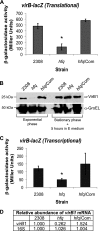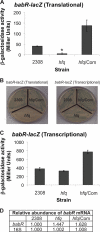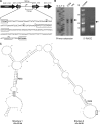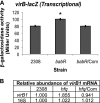The RNA chaperone Hfq independently coordinates expression of the VirB type IV secretion system and the LuxR-type regulator BabR in Brucella abortus 2308
- PMID: 22020650
- PMCID: PMC3256608
- DOI: 10.1128/JB.05623-11
The RNA chaperone Hfq independently coordinates expression of the VirB type IV secretion system and the LuxR-type regulator BabR in Brucella abortus 2308
Abstract
The type IV secretion system encoded by the virB operon is required for full virulence of Brucella sp., and the present study links the RNA chaperone Hfq to wild-type expression of virB in Brucella abortus 2308. Studies employing virB-lacZ fusions, quantitative reverse transcription-PCR, and immunoblot analysis showed that both transcription and translation of virB are decreased in an isogenic hfq mutant compared to those in the parental strain. These results led to the hypothesis that Hfq regulation of virB is mediated through an intermediate transcriptional regulator. Subsequent experiments determined that expression of the gene encoding the putative Brucella quorum-sensing regulator BabR (also known as BlxR), a known virB regulator, is also controlled by Hfq at the posttranscriptional level, and a cis-acting element in the 5' untranslated region of the babR transcript responsible for this regulation was identified. Consistent with its role as a virB regulator, recombinant Brucella BabR binds to the virB promoter region in electrophoretic mobility shift assays. However, experiments employing a babR mutant strain determined that BabR is a repressor, not an activator, of virB transcription. These findings suggest that Hfq regulates virB expression through both BabR-dependent and BabR-independent pathways.
Figures








Similar articles
-
Different Impacts of MucR Binding to the babR and virB Promoters on Gene Expression in Brucella abortus 2308.Biomolecules. 2020 May 19;10(5):788. doi: 10.3390/biom10050788. Biomolecules. 2020. PMID: 32438765 Free PMC article.
-
The two-component system BvrR/BvrS regulates the expression of the type IV secretion system VirB in Brucella abortus.J Bacteriol. 2010 Nov;192(21):5603-8. doi: 10.1128/JB.00567-10. Epub 2010 Sep 10. J Bacteriol. 2010. PMID: 20833814 Free PMC article.
-
Identification of the quorum-sensing target DNA sequence and N-Acyl homoserine lactone responsiveness of the Brucella abortus virB promoter.J Bacteriol. 2010 Jul;192(13):3434-40. doi: 10.1128/JB.00232-10. Epub 2010 Apr 16. J Bacteriol. 2010. PMID: 20400542 Free PMC article.
-
Metabolic control of virulence genes in Brucella abortus: HutC coordinates virB expression and the histidine utilization pathway by direct binding to both promoters.J Bacteriol. 2010 Jan;192(1):217-24. doi: 10.1128/JB.01124-09. J Bacteriol. 2010. PMID: 19854911 Free PMC article.
-
Regulation of virulence in Brucella: an eclectic repertoire of transcription factors defines the complex architecture of the virB promoter.Future Microbiol. 2013 Sep;8(9):1193-208. doi: 10.2217/fmb.13.83. Future Microbiol. 2013. PMID: 24020745 Review.
Cited by
-
Edwardsiella tarda Hfq: impact on host infection and global protein expression.Vet Res. 2014 Feb 25;45(1):23. doi: 10.1186/1297-9716-45-23. Vet Res. 2014. PMID: 24568370 Free PMC article.
-
Proline utilization system is required for infection by the pathogenic α-proteobacterium Brucella abortus.Microbiology (Reading). 2017 Jul;163(7):970-979. doi: 10.1099/mic.0.000490. Epub 2017 Jul 21. Microbiology (Reading). 2017. PMID: 28691659 Free PMC article.
-
Lysine Acylation Modification Landscape of Brucella abortus Proteome and its Virulent Proteins.Front Cell Dev Biol. 2022 Mar 1;10:839822. doi: 10.3389/fcell.2022.839822. eCollection 2022. Front Cell Dev Biol. 2022. PMID: 35300419 Free PMC article.
-
Decreased in vivo virulence and altered gene expression by a Brucella melitensis light-sensing histidine kinase mutant.Pathog Dis. 2015 Mar;73(2):1-8. doi: 10.1111/2049-632X.12209. Epub 2015 Feb 26. Pathog Dis. 2015. PMID: 25132657 Free PMC article.
-
Deletion of the Small RNA Chaperone Protein Hfq down Regulates Genes Related to Virulence and Confers Protection against Wild-Type Brucella Challenge in Mice.Front Microbiol. 2016 Jan 20;6:1570. doi: 10.3389/fmicb.2015.01570. eCollection 2015. Front Microbiol. 2016. PMID: 26834720 Free PMC article.
References
-
- Aiba H. 2007. Mechanism of RNA silencing by Hfq-binding small RNAs. Curr. Opin. Microbiol. 10:134–139 - PubMed
-
- Celli J, Grovel JP. 2004. Organelle robbery: Brucella interactions with the endoplasmic reticulum. Curr. Opin. Microbiol. 7:93–97 - PubMed
-
- Comerci DJ, Martínez-Lorenzo MJ, Sieira R, Grovel JP, Ugalde RA. 2001. Essential role of the VirB machinery in the maturation of the Brucella abortus-containing vacuole. Cell. Microbiol. 3:159–168 - PubMed
Publication types
MeSH terms
Substances
Grants and funding
LinkOut - more resources
Full Text Sources
Molecular Biology Databases

